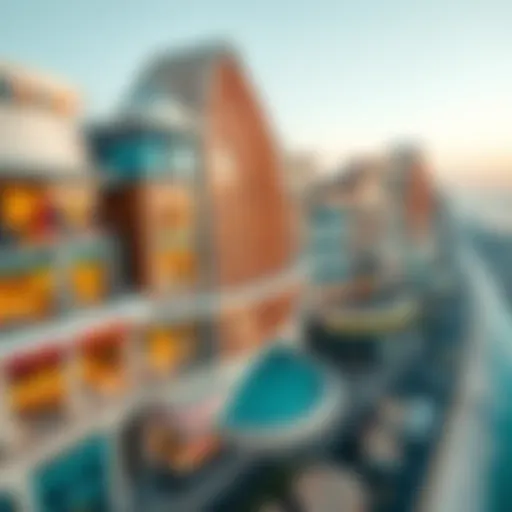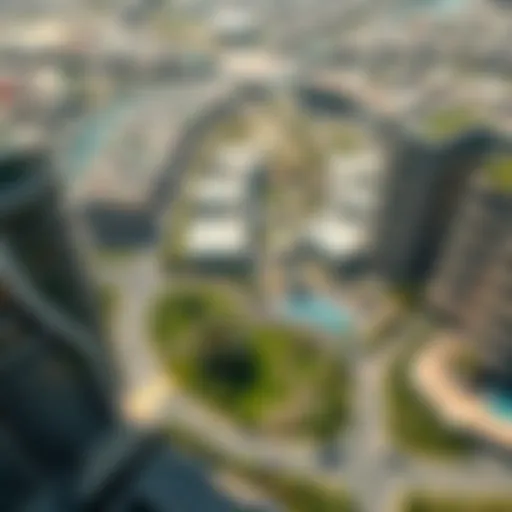Exploring the Charm of Historical Homes in the UAE
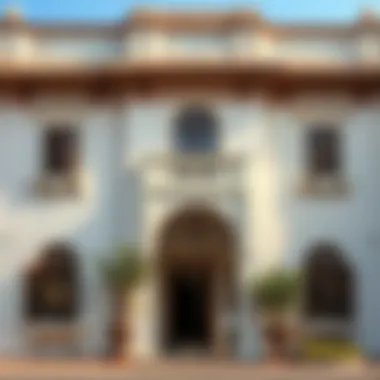

Intro
The allure of historical homes in the United Arab Emirates (UAE) is not just a fleeting interest; it represents a significant cultural renaissance that echoes throughout the region. As the modern skyline of cities like Dubai and Abu Dhabi stretches ever upward, a parallel movement is taking root, one that celebrates the traditional architectural gems that tell the story of the UAE's rich heritage.
In a world rapidly shifting towards contemporary designs and buildings that reach for the clouds, these historical homes are reminders of simpler times, showcasing craftsmanship that reflects the true essence of Emirati culture. Investors and homebuyers alike are increasingly drawn to these properties, not only for their distinctive aesthetic appeal but also for their cultural significance. These structures embody more than just walls and windows; they preserve stories of the past, infusing the present with a sense of place and identity.
This article delves deep into the charm and appeal of historical homes in the UAE, spotlighting the unique architectural styles, the factors that contribute to their rising popularity, and their implications for the current real estate market. By exploring this topic, we aim to provide insights for discerning investors, homebuyers, and real estate professionals who wish to understand the evolving narrative of Dubai's real estate landscape while recognizing the value of cultural heritage.
Market Trends in Dubai Real Estate
Current Market Overview
The Dubai real estate market presents a landscape where traditional and modern coexist, reflecting the city’s dynamic evolution. Historical homes, once overshadowed by towering skyscrapers, are now reclaiming their status as coveted properties. This renewed interest aligns with a global trend towards sustainability and heritage conservation.
According to various sources, such as Wikipedia and Britannica, data reveals a noticeable uptick in the demand for properties with historical significance, with buyers increasingly willing to pay premium prices for homes offering a glimpse into the UAE’s storied past.
Price Trends and Forecasts
In terms of pricing, the revival of historical homes is leading to a unique market segment where values are appreciating steadily. The average price for these homes is expected to rise, fueled by their limited availability and growing desirability. Brokers often highlight that traditional homes, especially those located in heritage-rich neighborhoods such as Al Fahidi and Jumeirah, have shown an increase of nearly 10% in the last year alone.
Investors should pay close attention to these trends:
- Increasing Demand: As the government invests in heritage sites and restorations, interest in cultural properties is on the rise.
- Future Projections: Experts predict that prices for historical homes will continue to climb as more buyers recognize their investment potential and cultural significance.
"The charm of historical homes lies not just in their aesthetics but in their ability to connect us with our past," notes one real estate expert.
The End
Understanding these market trends helps potential investors navigate the intricacies of Dubai's real estate scene, revealing opportunities that are not just financially rewarding but also culturally enriching. By perceiving traditional homes as more than mere transactions, stakeholders can gain a broader appreciation for the role these houses play in the mosaic of Dubai's identity.
For further reading, explore resources from local real estate portals, government statistics, and community discussions on platforms such as Reddit and Facebook.
Foreword to Historical Homes in the UAE
The United Arab Emirates is often seen as a modern wonder, with its towering skyscrapers and luxury shopping centers capturing the imagination of visitors and residents alike. However, nestled amidst this rapid development lies a treasure trove of historical homes, each telling a story as rich as the sands of the desert. Understanding the allure of these traditional structures is not merely an exploration of architecture; it's a journey into the heart of a culture that has evolved dramatically yet stays rooted in its customs and heritage.
Emphasizing the Importance
Why focus on historical homes in the UAE? These structures are more than just bricks and mortar; they are a testament to centuries of evolution, reflecting the societal values, traditions, and ways of life that have shaped Emirati identity. These homes, often adorned with unique architectural styles, play a significant role in maintaining a connection to the past in an increasingly fast-paced world. They invite people to explore a slower narrative, one grounded in community and history.
As there's been a renewed interest in cultural preservation and sustainable living over recent years, historical homes in the UAE stand at the crossroads of these two movements. They symbolize resilience and adaptability, reminding us that even amid change, some values remain timeless. Investors and homebuyers, in particular, are increasingly recognizing the potential of these properties, not just for their aesthetic appeal but also for their investment value and cultural significance.
Understanding the Cultural Context
To grasp the significance of historical homes in the UAE, one must first understand the cultural fabric of the region. The UAE, often seen as a melting pot of cultures, has been influenced by various peoples over the millennia, including the Bedouins, traders, and explorers who traversed the deserts and seas.
The traditional homes reflect this rich tapestry. For instance, the use of local materials such as coral and palm fronds in construction methods is a nod to the resources available in the region. Furthermore, the architectural designs are purposefully tailored to the climactic conditions, supporting a lifestyle that values community and hospitality. Many homes feature courtyards designed for gatherings, emphasizing the importance of kinship and social interactions.
Historical Significance of Traditional Structures
These traditional structures serve as pillars of historical significance, giving a glimpse into the way lives were once lived.
"Every crack in the wall tells a story, every room holds a memory."
From simple mud-brick houses to more complex designs featuring wind towers, each style provides insights into not only the architectural preferences but also the lifestyle choices of their inhabitants. For instance, wind towers—known locally as barjeel—reflect ingenious adaptations to the harsh climate, allowing residents to enjoy a natural ventilation system long before air conditioning became commonplace.
Furthermore, preserving these homes is a way of safeguarding the cultural heritage for future generations. They are a reminder of a time when life revolved around community interaction, trade, and familial bonds, contrasting sharply with the current fast-paced, technology-driven lifestyle.
In summary, the historical homes dotting the landscapes of the UAE represent more than just beautiful architecture—they are a fundamental part of the nation’s identity and cultural history. Understanding their allure offers a unique perspective for investors and homebuyers alike, encouraging a more profound appreciation for the value these structures hold in today’s world.
Architectural Styles of Traditional Houses
The architectural styles of traditional houses in the UAE provide a fascinating glimpse into the cultural heritage and historical contexts that shaped them. Each style, with its unique characteristics, reflects the ingenuity of local craftsmanship and the environmental adaptations made by the people of the region. Understanding these styles is essential not just for appreciating the aesthetic qualities of these homes but also for recognizing their roles in the broader narrative of identity and history.
Barasti Houses: A Reflection of Bedouin Life
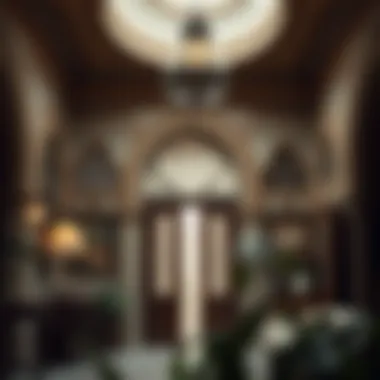

Barasti houses are one of the most iconic representations of traditional Emirati architecture. Constructed mainly from palm fronds, these structures showcase the resourcefulness of the Bedouin people. The principles behind building a Barasti house were deeply rooted in the need for shelter that offered both comfort and protection from the harsh desert environment. Their construction process utilized local materials, mainly the palm trees that thrived in the region.
The open design promotes natural ventilation—vital for coping with the sweltering temperatures of the desert. These houses typically feature high, thatched roofs and thick walls, creating cool interiors that remain comfortable throughout the day.
"Barasti houses reminded us of the old ways, where life was simple, and the focus was on community and the strength of the family unit."
Moreover, Barasti houses were also a symbol of status among the Bedouins. Large sections of these homes often served as spaces for gathering, demonstrating the significance of social interaction in Bedouin culture. The decline of this style in modern architecture doesn’t erase its importance; rather, it presents a compelling case for restoration and preservation efforts as a nod to a distinct historical identity.
Wind Towers: Ingenious Climate Adaptations
Wind towers, or "Barjeel," represent a marvel of ancient technology, originally developed to provide natural cooling in homes. These structures can be identified by their towering, open-air designs, strategically placed to catch the cooler breezes. In the sweltering heat, these towers served as passive ventilators, channeling a steady flow of fresh air throughout the house.
The architectural brilliance in their design is evident, as wind towers utilize the region's unique wind patterns to maintain a comfortable indoor climate without relying on modern air conditioning systems. Their presence is a testament to the sustainable living practices that were integral to Emirati culture long before the onset of globalization.
In contemporary times, there’s a resurgence of interest in integrating wind towers into new builds as a sustainable solution that also pays homage to traditional aesthetics. The balance between preservation and modernization is crucial in ensuring that these structures remain part of the landscape, embodying both innovation and tradition.
Coral Stone Houses: Heritage from the Sea
Coral stone houses, primarily found in coastal cities like Dubai and Abu Dhabi, represent a unique blend of natural materials and architectural flair. Traditionally, builders utilized coral from the Arabian Gulf, a resource that not only provided durability but also an attractive surface that naturally blends into the surrounding environment.
These houses often feature thick walls and arched windows, allowing for insulation against the heat while creating a visually striking facade. Due to the porous nature of coral, these homes also regulate temperature effectively, making them comfortable year-round.
The appeal of coral stone houses goes beyond their functionality; they are imbued with stories of maritime heritage and the space where the sea and land meet. As the modern real estate market trends favor properties that tell a story, restoring and preserving these coral homes has become increasingly vital.
By maintaining these traditional structures, the UAE not only protects its cultural history but also reinforces a sense of community identity rooted in shared experiences and environmental connection.
Factors Influencing Popularity
The surge in interest surrounding historical homes in the UAE is not simply a fleeting trend; it resonates deeply with the nation’s cultural narrative and environmental considerations. This section aims to unravel the multiple factors that contribute to their growing appeal, examining the intricate balance of cultural revival alongside eco-consciousness in the context of modern living.
Cultural Revival and National Identity
The allure of historical homes can largely be attributed to their embodiment of the rich cultural tapestry of the UAE. Residents and investors alike are recognizing that these homes are not merely structures of brick and mortar; they represent the history and identity of a nation that has transformed at a breakneck speed. A resurgence of interest in traditions and heritage has sparked a movement among the younger generations to reconnect with their roots.
- Heritage festivals, local art exhibitions, and community events focused on preserving traditional crafts have painted a vibrant picture of the UAE’s past.
- People have increasingly started looking at properties like the Barasti houses and coral stone edifices not just as homes, but as stories waiting to be told.
Notably, the integration of these homes into community life enhances national pride. Transforming historical residences into cultural hubs, such as museums or community centers, bridges the gap between generations. Investing in these properties becomes an act of stewardship, fostering a sense of belonging and purpose.
Sustainable Living and Eco-conscious Trends
In today’s climate-conscious society, sustainability is more than just a buzzword; it’s a lifestyle choice that influences how people view historical homes. Many of these properties are inherently eco-friendly due to their design and materials. For instance, houses equipped with wind towers not only echo the architectural ingenuity that prevailed, but they also function as natural cooling systems, reducing energy consumption.
- The resurgence of interest in green solutions manifests in various ways:
- Smart technology integrated into traditional frameworks helps preserve historical charm while offering modern conveniences.
- Reclamation and restoration projects often focus on using sustainable materials, ensuring that the integrity of the original structure is maintained without compromising environmental commitments.
Investors and buyers today appreciate how historical homes allow for sustainable living without sacrificing style. There’s a discerning realization that these properties can act as catalysts for eco-conscious lifestyles, making them not just valuable in a monetary sense but beneficial for the planet as well.
Historical homes are a canvas for cultural expression and sustainability. When preserved, they narrate tales of resilience while promoting innovative, eco-friendly living.
The convergence of cultural renewal and sustainable practices creates a compelling case for investing in historical homes, positioning them as desirable assets in the contemporary real estate landscape. Understanding these factors facilitates thoughtful decisions, whether one is looking to invest, buy, or simply appreciate the significance of these treasured structures.
Challenges in Preserving Historical Homes
Preserving historical homes in the UAE isn't just about keeping the past alive; it's also about making sense of how history interacts with the fast-paced modern world. The growing interest in these traditional structures raises many questions: How do we ensure they adapt while retaining their essence? As investors and homebuyers seek unique properties, understanding the challenges of preservation becomes crucial. The value of these homes lies not only in their aesthetics and history but also in their potential to provide a sustainable living solution.
Balancing Modernization with Preservation
Striking a balance between modernization and preservation can feel like walking a tightrope. On one hand, the demand for modern amenities increases with each passing year, driven by a new generation of homeowners who prioritize comfort and efficiency. On the other hand, there's a deep respect for these structures as monuments of cultural heritage.
Imagine a home that once housed important historical figures being converted into a contemporary café, offering barley coffee and vegan cupcakes. While this might attract a crowd, it calls into question the steps taken to honor the building's past.
In addressing this delicate balancing act, it's essential to consider a range of factors that contribute to both preservation and modernization:
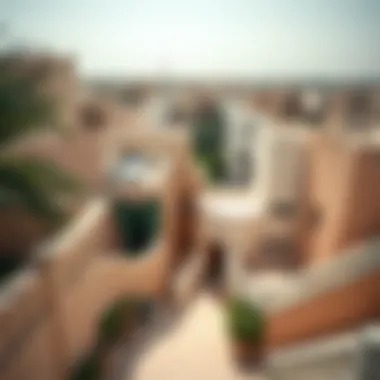

- Community Engagement - Involving local communities in the decision-making process can help ensure that modernization efforts respect historical significance.
- Adaptive Reuse - This concept suggests transforming a building's purpose while retaining its character. A prime example would be turning an old fort into a boutique hotel.
- Emphasis on Sustainable Practices - Using eco-friendly materials and energy-efficient installations can be part of restoring historical homes without compromising their integrity.
Legal and Regulatory Barriers
Navigating regulatory environments presents its own unique set of challenges. In many cases, laws designed to protect historical sites can also stifle innovative solutions that enhance their viability in today’s market. There may be conflicting regulations concerning zoning, renovations, or additions that can discourage developers from pursuing restoration projects.
Consider the following points:
- Heritage Protection Laws - These laws can sometimes lead to bureaucratic delay, hindering timely conservations, and improvements.
- Zoning Regulations - These can restrict changes to structures, limiting their use in the economic landscape.
- Funding Challenges - While government programs may exist to support historical preservation, applicants often face a maze of paperwork that can deter investment.
A committed approach to advocacy can help bridge this divide, encouraging reforms that empower rather than encumber. For any investor or homebuyer, understanding these barriers can make all the difference in navigating the complex landscape of historical property ownership.
"Historical homes are more than mere buildings; they’re testimonies of a culture, requiring a harmonious commitment to both their stories and their future."
As we delve into these challenges, it's vital to keep an eye on the long-term vision, fostering an environment where history and modernity coexist gracefully.
Real Estate Market Trends
Understanding the real estate market trends for historical homes in the UAE is crucial, especially as the nation navigates its rapid modernization while still cherishing its cultural roots. This balance between the old and the new creates a unique landscape for investors and buyers alike, making historical properties an intriguing market niche. Investors often find that these homes hold a value beyond their physical structure; they are gateways into the cultural identity of the region.
Investment Opportunities in Historical Properties
Investing in historical properties in the UAE is not just about owning a piece of the past; it’s a strategic financial move that can yield substantial returns. The market has shown a growing interest in these properties, fueled by a cultural revival and a surge in national pride.
- Cultural Appeal: Investors are drawn to the stories that historical homes tell. Owning one allows homeowners to connect with the rich heritage of the UAE, which can enhance personal satisfaction and community involvement.
- Rising Popularity: As more buyers seek unique homes with character, the demand for historical properties rises, potentially leading to increased property values over time.
- Renovation Potential: Many older homes can be transformed into modern amenities while retaining their historical charm, allowing investors to command higher prices after renovation.
Additionally, government initiatives aimed at promoting heritage tourism can increase interest in these properties, translating into more robust rental prospects for investors. For example, developers might consider properties like Sheikh Saeed Al Maktoum House for their unique characteristics and the opportunity for tourism.
Market Dynamics: Supply and Demand
In the world of real estate, supply and demand are principles that can make or break an investor's fortune, particularly in a specialized market like historical homes. The landscape is shaped by various factors:
- Demand Factors: The increasing appetite for unique, culturally rich living spaces is evident. Many expatriates and locals prefer homes that reflect their heritage, which creates a solid and growing customer base. The attraction of history in daily living fosters an ongoing demand for these properties.
- Supply Issues: While the interest in historical homes is on the rise, the actual supply is often limited. Many historical properties are preserved rather than restored for modern living, keeping these gems scarce. This scarcity can lead to bidding wars or rapid sales, particularly in prime locations like Al Fahidi Historical Neighborhood.
To summarize, the interplay of supply constraints and growing demand establishes historical homes as a valuable sector of the UAE real estate market. Investors are encouraged to stay informed about both trends to make savvy business decisions in this unique environment.
Case Studies of Iconic Historical Homes
Delving into the narratives surrounding historical homes offers us a richer understanding of their cultural and architectural significance. Case studies such as the Sheikh Saeed Al Maktoum House and the Al Fahidi Historical Neighborhood exemplify how history intertwines with modern life in the UAE. These homes serve as tangible links to the past, showcasing unique architectural styles and the lives of those who inhabited them. Investigating these historic structures not only reveals their artistic craftsmanship but also highlights the continuous community efforts to preserve and celebrate the nation’s heritage.
Sheikh Saeed Al Maktoum House
This house stands as a proud testament to the heritage of Dubai and its ruling family. Sheikh Saeed Al Maktoum, the grandfather of the current ruler, built this majestic structure in 1896. The home, with its coral stone and lime plaster, exemplifies traditional Emirati architectural techniques that were suited to the local climate.
Notably, the house serves a dual purpose today: it acts as both a museum and a cultural heritage site, attracting both locals and tourists alike. Inside, you'll find artifacts, photographs, and documents that tell the story of Dubai's evolution. This is crucial for investors and homebuyers interested in properties that gain value from their historical context.
"Sheikh Saeed Al Maktoum House doesn't just preserve the past—it breathes life into it, helping us appreciate how far we've come while keeping our roots firmly planted."
Moreover, by engaging with this site, one can see the implications for real estate development in the area. The home stands in stark contrast to the glittering skyscrapers that now delineate Dubai's skyline. But this mix of old and new is what makes the emirate so captivating, enhancing the appeal for both buyers looking for a piece of history and investors wanting to tap into the rising trend of heritage tourism.
Al Fahidi Historical Neighborhood
The Al Fahidi Historical Neighborhood, previously known as Bastakiya, is an area that truly captures the essence of traditional Emirati life. Walking through its narrow lanes, one can’t help but feel transported back in time. The neighborhood is characterized by wind towers, courtyard houses, and intricate plasterwork, representing a collective architectural style that emphasizes community and collaboration.
Several galleries and museums, including the Dubai Museum, are situated within this enclave, further enriching its cultural tapestry. The revival efforts in Al Fahidi have made it a hub for artists, businesses, and community initiatives that promote the city’s history. This combination of old-world charm and modern practicality makes it an attractive spot for homebuyers and investors alike, underscoring the importance of marrying tradition with modernity.
By preserving such neighborhoods, the UAE not only safeguards its cultural heritage but also creates a vibrant community space that resonates with a variety of demographics, making it suitable for long-term investment.
Whether it’s the Sheikh Saeed Al Maktoum House or the Al Fahidi neighborhood, both hold lessons in preservation and adaptation. They inspire a commitment among policymakers, investors, and ordinary citizens alike to keep the essence of the UAE's past alive against the backdrop of its rapidly modernizing landscape.
The Role of Community Initiatives
Community initiatives play a crucial role in preserving historical homes in the UAE, acting as the backbone for both awareness and action. These efforts often aim to invigorate local heritage, enabling residents and visitors to experience the rich tapestry of culture woven through these architectural marvels.
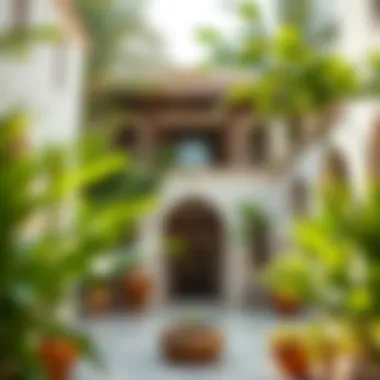

The growing recognition of these initiatives is evident in the ways they engage diverse groups—traditionalists, investors, and the average community member alike. Many people are drawn to the charm and legacy of historical homes, but without substantial community backing, these structures risk falling into disrepair or obscurity. Through grassroots movements and various programs, individuals and organizations are championing the cause of preservation, ensuring future generations can appreciate their cultural legacy.
Non-Profit Organizations in Heritage Preservation
Non-profit organizations are often at the forefront of heritage preservation efforts in the UAE. These groups dedicate their resources not just to restoration projects, but to increasing public knowledge about the intrinsic value of historical houses. One notable organization is Dubai’s Heritage and Diving Village, which serves to educate the public about the traditional lifestyle of coastal communities in the region. The efforts made by such organizations help bridge the gap between the past and present, prompting a sense of community pride.
The benefits of these non-profit initiatives are manifold:
- Educational Programs: Workshops and tours not only raise public awareness but also instill a sense of responsibility in preserving heritage.
- Collaborative Efforts: They often work closely with local governments and international bodies, creating a network of support that can amplify their voice.
- Resource Mobilization: Non-profits are skilled at fundraising and can channel funds into restoration, thus alleviating the financial burden from local authorities.
These organizations thrive on community involvement. People take part in restoration projects as volunteers, fostering a connection to their heritage. Such engagement enhances community ties, as individuals come together to learn and work side by side.
Government Support and Funding Programs
Government initiatives provide robust support that underpins many community-led efforts to preserve historical homes. Public funding can take many forms, including grants, tax incentives, and assistance with regulatory frameworks, all tailored to encourage restoration and maintenance of traditional buildings. An example of this is the UAE's commitment to its National Architecture Policy, which promotes the conservation of historical sites as part of its cultural strategy.
Central to this support are several key components:
- Grants for Restoration: National and local governments often allocate funds specifically for the repair and maintenance of historical homes, making preservation financially viable for owners.
- Public Awareness Campaigns: The government collaborates with community groups to run campaigns that educate the public about the importance of maintaining historical integrity and cultural identity.
- Regulatory Support: Streamlining the permitting process for home restorations reduces obstacles for community members wishing to invest time and money into historical properties.
Through these channels, government support serves as a catalyst for community initiatives. For investors, it presents an opportunity; when the state has a vested interest in preserving historical sites, it enhances the value of such properties, making them a sound investment.
"Preserving our past enriches our future. The past needs nurturing to ensure the vibrancy of our communities continues on."
Future of Historical Homes in the UAE
As the United Arab Emirates strides towards a future that combines rapid modernization with a deep respect for its past, the fate of its historical homes emerges as a topic of paramount importance. These structures, steeped in culture and history, symbolize a unique architectural identity. Their preservation and adaptation are not mere acts of nostalgia; they present significant benefits for communities, investors, and future generations alike. In a rapidly urbanizing landscape, where glass and steel towers frequently compete for attention, historical homes offer much-needed balance and serve as reminders of the UAE's rich heritage.
The allure of these historical homes is multifaceted. They hold potential as cultural landmarks, tourist attractions, and luxurious residences while embodying sustainable living through the practice of restoration and adaptive reuse. Investors, homebuyers, and real estate agents are increasingly keenly aware of how these properties contribute to a vibrant community fabric and a distinctive skyline. Thus, understanding the future of historical homes in the UAE is essential to leveraging their cultural and economic potential.
Innovative Approaches to Restoration
In the realm of restoration, innovative methodologies are emerging. Today, architects and conservationists are not just looking to preserve structures; they're finding ways to rejuvenate them without losing their original charm. For instance, using traditional materials alongside modern construction techniques is a trend gaining traction. Using local limestone, which has been a building staple in the region for centuries, combined with eco-friendly paints can breathe new life into aged structures while maintaining their historical essence.
Furthermore, mimicking traditional architectural design can safeguard these homes' historical integrity while accommodating modern lifestyles. This delicate balance often involves:
- Community involvement: Local voices are central to the restoration process, ensuring that the works reflect the community's cultural identity.
- Sustainability assessments: Identifying green technologies and renewable energy systems that can be integrated into these restorations not only helps in preservation but also appeals to environmentally conscious buyers.
Utilizing these innovative restoration approaches safeguards the architectural style while enhancing the living experience. As such, forward-thinking investors and developers acknowledge that the value of historical homes can be preserved or even enhanced through thoughtful restoration.
Integrating Technology in Preservation Efforts
The digital age presents unprecedented opportunities for the preservation of historical homes in the UAE. Utilizing technology, stakeholders can create synapses between the past and the present. Techniques such as 3D scanning and BIM (Building Information Modeling) allow preservationists to document existing conditions meticulously, which is crucial when planning restorations or renovations.
Moreover, augmented reality (AR) can offer immersive experiences for both potential buyers and tourists, providing virtual tours that showcase the house's history and architecture without the need for physical alterations. This tech-driven approach not only provides insight into the building's past but also engages a younger demographic curious about its story.
Additionally, leveraging digital platforms for marketing historical properties can expand their reach. For instance, engaging social media outlets and real estate databases grants visibility to unique listings that tell compelling narratives, drawing interest from global audiences. The use of technology, thus, paves the path forward—merging heritage with innovation, creating a future where historical homes continue to captivate and inspire.
"Preservation is not just about maintaining the past; it’s about creating a vibrantly adaptive future that respects and honors what came before."
Whether it’s through innovative restoration techniques or the integration of technology, the future of historical homes in the UAE will rely on a synergy between tradition and progress. For those invested in the real estate market, these homes represent a unique opportunity to engage with a narrative that is both culturally rich and economically viable.
Ending
As we wrap up our exploration of the charm and significance of historical homes in the UAE, it becomes clear that these structures are more than just bricks and mortar. They embody a rich tapestry of cultural narratives and identities that have shaped the nation’s history. Understanding their importance is essential, especially in today's rapidly changing environment where tradition often wrestles with progress.
Summarizing the Importance of Historical Homes
These homes serve as a physical manifestation of the UAE's heritage, offering a glimpse into the lives of those who came before. The unique architectural styles, such as Barasti houses and coral stone structures, reflect the resourcefulness of communities in adapting to their surroundings. Each building tells a story, encapsulating local craftsmanship, cultural practices, and evolutionary design approaches over decades.
Additionally, these historical sites are central to fostering a sense of national pride and identity. Preserving them contributes to educational opportunities for younger generations and tourists alike. It creates a bridge, linking the past with the present, thereby enriching the understanding of the UAE's historic landscape. In many ways, these homes are like the grandparent in a sprawling family; they hold wisdom and stories, serving as a cornerstone to which everything else can relate.
Looking Ahead: A Commitment to Preservation
Looking to the future, a commitment to preserving these historical gems cannot be overstated. Investment in preservation efforts is not just about maintaining buildings; it’s about sustaining a connection to cultural history that is all too easy to overlook in an age of glass towers and rapid urbanization. Government and community initiatives play pivotal roles in promoting awareness and ensuring the survival of these homes.
Innovative restoration methods and technology, such as digital mapping and eco-friendly materials, offer hope in these efforts. By embracing a holistic approach to restoration, integrating modern techniques while respecting traditional craftsmanship, we pave the way for architectural evolution that is both respectful and forward-looking.
Ultimately, the allure of historical homes lies in their ability to keep the stories of the UAE alive, weaving past and present into a narrative that champions heritage while embracing the future. It is this delicate balance that will serve as the backbone of cultural preservation efforts moving forward—from investors looking for unique properties to real estate professionals advocating for responsible development.



